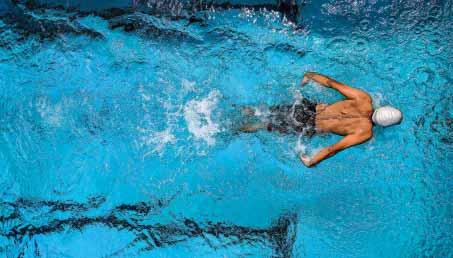
4 minute read
Driving Down Operational Expenditure

Installation of DualSun panels at the UQ Sport Aquatic Centre on the University of Queensland’s St Lucia campus.
Advertisement
James Croll looks at a French solar heating innovation that reduces energy costs and substantially reduces facility operating costs
Aquatic centres are often the highest energy-consuming assets for local councils, with the heating and cooling needs for large pools and aquatic centres representing a huge cost to councils, schools and other private operators - as well as a major source of emissions.
Energy is consumed in heating water for the pool and for showers; heating and cooling the indoor areas to maintain a comfortable temperature; lighting for indoor and outdoor areas; and powering pool filtration pumps, electrical appliances and equipment. In addition, enormous amounts of hot humid air leaves buildings which is then replaced by outdoor air that must be heated or cooled.
This need to reduce costs, and indeed have some semblance of stability, along with the growing need to provide sustainable solutions has been the main driving force behind design and innovation across virtually all suppliers to the commercial aquatic industry.
It was a major focus for Supreme Heating, Australia’s leading provider of commercial aquatic heating solutions and the answer came at the Piscine aquatic conference in France in 2017, where the Supreme directors came across a groundbreaking commercial solar heating system - DualSun.
Becoming the sole distributor for DualSun in Australia shortly thereafter, Supreme Heating Commercial Manager, Anthony Denahy explains “it was apparent that DualSun was not only one of the most efficient solutions for the heating of commercial pools, but what excited us most was that it went far beyond pool heating in that the product also promised to substantially reduce operating costs across an entire facility.
“DualSun’s panels are particularly well-adapted for pool heating because they have better thermal performance at low heating temperatures. They optimise roof space by producing heated water and maintain the temperature of the pools using a plate heat exchanger, with a backup boiler during winter months (if required) and preheat the hot water system using a second plate heat exchanger and a solar hot water tank.
“Heatseeker DualSun is a multi-energy hybrid solar panel, that consolidates two technologies into one panel. The DualSun technology delivers electricity and heated water, without changing the size or design of a standard photovoltaic panel.
“But the key is that the electricity generated can be used directly in the building during the day, and any surplus electricity can be returned to the grid. It’s this that has had a dramatic impact on reducing operating costs of aquatic venues in Europe and is now having a significant impact on facilities across Australia.”
In simple terms the DualSun product simultaneously produces electricity and heating for pools and other hot water applications – technology that has secured a range of awards for sustainability, including receiving SPASA Australia’s Product of the Year Award along with SPASA South Australia and SPASA Victoria’s Gold Award for sustainability in 2018.
Supreme’s recent project at the University of Queensland had 326 DualSun panels installed, providing electricity for their buildings whilst also heating their three pools. The system has provided the university with an initial 90% offset of all associated heating.
The DualSun product was taken up a further level in 2021 with the unveiling of DualSun’s photovoltaic-thermal panel based on shingle solar cells. Shingle solar cells are solar cells which are cut into typically five or six strips. These strips can be overlaid, like shingles on a roof, to form the electrical connections. The strips of solar cells are joined together using an electrically conductive adhesive (ECA) that allows for conductivity and flexibility.
The photovoltaic-thermal panel has been the most powerful device developed by the company to date. The shingle cells allowing the panel to reach a power of 375 W as opposed to a previous maximum of 315 W. Apart from the efficiency, the product is highly durable as shingle cells are less affected by micro-cracks so the decrease in yield over time is considerably lower.
It is not just its ability to reduce operating costs however that is seeing DualSun being embraced by the commercial aquatic sector but the fact that the solution fits the socio-demographic drivers of today’s communities. Both aquatic centres and communities themselves require sustainable solutions. Indeed, sustainability is no longer an optional extra, but a fundamental aspect of functional design.
As Denahy adds “great design creates ongoing value for people and communities while minimising costs over time.
“With its ability to provide sustainable and renewable solar energy, in the form of electricity and thermally heated water in one panel, the DualSun technology helps to drive down the operational expenditure of Aquatic Centres, allowing budget to be placed back into community programs, extending the value of the centre.” James Croll is Partnerships Manager at Australasian Leisure Management.










